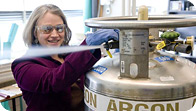MIT’s Laboratory for Nuclear Science (LNS) studies the fundamental laws of nature and seeks to answer basic questions about the origin and structure of our universe. LNS is the organization where MIT faculty, staff and students carry out both experimental and theoretical research in nuclear and particle physics. Over 40% of the current MIT Physics Department faculty supervising more than 90 graduate students conduct their research in LNS. In 2006, LNS celebrated its 60th birthday and currently has more than 300 people active in frontier research worldwide.
LNS researchers have played a leading role in the great progress made in understanding the structure of matter over the last half century and are actively charting the exciting new directions for the future. Four Nobel Prizes in Physics have been awarded to MIT faculty in LNS. The most cited research paper in physics is by Steven Weinberg (himself a Nobel Laureate in Physics) published in 1967 for work carried out at LNS.
Research at LNS is primarily supported by the Offices of High Energy Physics and Nuclear Physics in the United States Department of Energy Office of Science and the National Science Foundation.

The central research themes at present at LNS include:
Determining the Fundamental Laws of Nature
Understanding the Large Scale Structure of the Universe
Exploring the High Energy Frontier
Understanding Atomic Nuclei
Development of New Research Tools

More than 600 graduate students at MIT have written Ph.D. theses on research carried out in LNS. The skills and knowledge acquired in attaining an MIT Physics Ph.D. in nuclear or particle physics are highly sought after and LNS students can be found in private industry, government, academia, and research laboratories around the world. Past LNS graduate students have included Murray Gell-Mann, one of the architects of the Standard Model of Physics and Burton Richter, the co-discoverer of the charmed quark.
Graduate students in LNS focus early on mastering the rigorous curriculum in fundamental principles demanded of all MIT Physics Ph.Ds. Typically, by the third year the student is actively engaged in frontier research under a faculty supervisor. This research will often include significant participation at research facilities around the world. By the fifth year, most students are analyzing their thesis data, preparing for the final thesis defense and choosing among a number of exciting career options.
To carry out its research and education mission, LNS maintains a number of important MIT facilities. These are essential to on-campus activities and allow the direct participation of MIT students in LNS research. They include:
The Bates Research & Engineering Center
This center has a staff of approx. 30 physicists, engineers and research support staff and carries out research and engineering in support of LNS faculty research. In particular, there is a group of accelerator physicists which designs and develops new particle accelerators.
The MIT Central Machine Shop
LNS operates a machine shop for MIT with a staff of 10 to design and fabricate custom hardware.
The Research Computing Services Group
A group of 4 computer professionals provides the research computing support for over 200 LNS staff, who are distributed around the world.
Societal Impact of LNS Research
LNS research activities benefit society in a number of important ways. LNS students can be found working in nuclear medicine, developing new techniques to screen cargo for dangerous materials, and in the financial markets. LNS faculty routinely advise the government on matters related to energy, security and science.